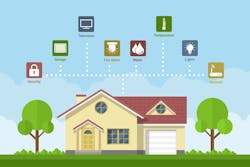Home security system capabilities to evolve with the IoT
When consumers install an alarm in their homes, they’re thinking about preventing a break-in, not disarming an intrusion alarm from a thousand miles away. But the Internet of Things (IoT) promises to unsettle the notion of a traditional home security system—including the risks it mitigates. In 2014, the number of mobile devices in use officially surpassed the population of Earth, and with the market opening up for connected home goods, the rise of an IoT home is imminent. Futurists predict the wave will culminate in a series of connective devices and surfaces installed throughout the home. This would mean objects that “talk” to each other using machine-to-machine communication, allowing homes to be smarter. They’d collect user preferences and predict necessary adjustments ahead of time, without constant input from an end user.
The Role of Home Security in Device Connectivity
Home security systems are at the forefront of this movement. They’re a technology that already relies on feedback from motion sensors, and if smart objects are the brains of the coming IoT revolution, then sensors are its five senses, harvesting collected information and channeling it back to devices for interpretation. But the complicated data processing of smart objects dictates a sensor that can collect more than just movements—environmental and pressure sensors will be in use as well, objects that can read a variety of conditions, from the humidity in a home to its radon levels. The next wave of home security products will be able to detect potential burglaries as easily as they can assess threats from environmental hazards.
That means that the enormous task facing developers is unifying devices through a single communication protocol—getting all smart objects on the same page, so to speak. We’re already starting to see Google, Apple, and Amazon offering up their solutions to the issue through home hubs and smart hardware systems. Meanwhile, security devices are appearing on the market, like those offered by Piper, that are taking the “home system” approach—rolling alarm controls together with HVAC monitoring and lighting. Multi-functionality is a huge advantage in the burgeoning world of IoT, and the next home security system will be no different—its success will be predicated on how effectively it can communicate with other controls in a home. For instance, imagine an alarm that could alert home lighting to flash in the event of a break-in, or lock a door if a perceived threat is detected. That kind of fluidity between systems will make security devices more powerful than ever before.
Changes to home design that affect security systems
Meanwhile, there’s also a prediction that new homes will be built with safe rooms installed. Much like the notorious panic room of cinema fame, these are fortified structures designed into homes expressly to form a reinforced seal in the event of a threat—not only from armed intruders, but also weather events. Concrete and steel structures in these rooms protect homeowners from hurricanes and other severe weather events that may pose a risk as climate change advances. Smart security systems will monitor activity inside the home as well as environmental data, and will wall off the safe area in the event of an emergency.
Adapting security systems to mitigate cybercrime
Integrating functionality among devices and allowing them to harvest data about homeowners’ movements, preferences and even conversations poses a risk for cybercrime. Hackers infiltrating systems could gain control of locks, garage door controls, or even exploit information from sensitive conversations—credit card or social security numbers, for instance. Security in homes will need to adapt to respond to not only a physical break-in but also a data leak, and it will need to happen sooner, rather than later. In the rush to push out smart devices, manufacturers have left programming vulnerabilities exposed that put the homeowners who use them at huge risk. Earlier this year, a contributor to Forbes was able to hack into the smart security system for the East Oakland Youth Development Center by simply entering in the default admin credentials. Meanwhile, Network World reported last year about a Russian site hosting streaming footage from thousands of unsecured home security webcams. Flaws like not requiring two-factor password authentication or expiring default passwords present a massive breakdown in smart security, all of which may add up to an even greater threat than a physical intruder.
While these issues have some declaring smart homes “dumb,” security concerns need not provoke our luddite tendencies. Authentication protocols will have to become more standardized, yes, but the risk posed by cybercriminals also presents an opportunity for home security manufacturers to expand their devices’ functionality. A smart security system seems like the most obvious place to trigger an alarm in the event of a hack. In fact, that’s just what this new device from NewDealDesign is programmed to do—it sniffs out foreign IP addresses and malware and alerts homeowners of suspicious behavior, activating a chat window with a professional who can lead them through the steps to secure their home. That professional connection is important, since details like securing routers and even selecting quality passwords often elude those not familiar with the basics of IT security. Encryption may be an even better solution then, coming in the form of global trust identity networks, as these provide device encryption services for IoT objects and authentication measures to detect fraudulent activity, which may one day be as important to theft prevention as a lock and alarm. All in all, home security systems are poised to grow much more robust—that is, if they are to be equipped to handle the wider variety of security concerns that will face tomorrow’s homeowners.
About the Author: Erin Vaughan writes about home automation, IoT, and environmental issues for Modernize.com. Her work can be found there and on other sites around the web.
